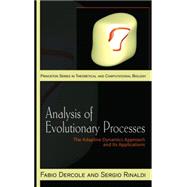
Note: Supplemental materials are not guaranteed with Rental or Used book purchases.
Purchase Benefits
What is included with this book?
| Preface | p. xi |
| Introduction to Evolutionary Processes | p. 1 |
| Origins of Evolutionary Theory | p. 1 |
| Genotypes and Phenotypes | p. 5 |
| Mutations | p. 9 |
| Selection | p. 10 |
| Evolution | p. 13 |
| The Red Queen Hypothesis | p. 16 |
| The Emergence of Diversity | p. 17 |
| Evolutionary Extinction | p. 21 |
| Examples | p. 24 |
| Modeling Approaches | p. 43 |
| Overview | p. 43 |
| Population Genetics | p. 47 |
| Individual-based Evolutionary Models | p. 53 |
| Quantitative Genetics | p. 55 |
| Evolutionary Game Theory | p. 59 |
| Replicator Dynamics | p. 62 |
| Fitness Landscapes | p. 64 |
| Adaptive Dynamics | p. 67 |
| A Comparative Analysis | p. 70 |
| The Canonical Equation of Adaptive Dynamics | p. 74 |
| The Evolving Community | p. 74 |
| The Resident-Mutant Model | p. 76 |
| The Example of Resource-Consumer Communities | p. 79 |
| Does Invasion Imply Substitution? | p. 83 |
| The AD Canonical Equation | p. 88 |
| Evolutionary State Portraits | p. 95 |
| Evolutionary Branching | p. 99 |
| The Role of Bifurcation Analysis | p. 110 |
| What Should We Expect from the AD Canonical Equation | p. 116 |
| Evolutionary Branching and the Origin of Diversity | p. 119 |
| Introduction | p. 119 |
| A Market Model and Its AD Canonical Equation | p. 121 |
| A Simple Example of Technological Branching | p. 129 |
| Discussion and Conclusions | p. 135 |
| Multiple Attractors and Cyclic Evolutionary Regimes | p. 138 |
| Introduction | p. 138 |
| A Model of Resource-Consumer Coevolution | p. 139 |
| The Catalog of Evolutionary Scenarios | p. 144 |
| Discussion and Conclusions | p. 151 |
| Catastrophes of Evolutionary Regimes | p. 153 |
| Introduction | p. 153 |
| A Model for the Evolution of Cooperation | p. 154 |
| Catastrophic Disappearance of Evolutionary Attractors | p. 159 |
| Evolutionary Branching and the Origin of Cheaters | p. 166 |
| Discussion and Conclusions | p. 169 |
| Branching-Extinction Evolutionary Cycles | p. 172 |
| Introduction | p. 172 |
| A Model of Cannibalistic Demographic Interactions | p. 174 |
| Coevolution of Dwarfs and Giants | p. 177 |
| The Branching-Extinction Evolutionary Cycle | p. 182 |
| Discussion and Conclusions | p. 183 |
| Demographic Bistability and Evolutionary Reversals | p. 186 |
| Introduction | p. 186 |
| Biological Background | p. 188 |
| Asymmetric Competition and the Occurrence of Evolutionary Reversals | p. 189 |
| Slow-Fast Approximation of the AD Canonical Equation | p. 195 |
| Discussion and Conclusions | p. 200 |
| Slow-Fast Populations Dynamics and Evolutionary Ridges | p. 204 |
| Introduction | p. 204 |
| Biological Background | p. 207 |
| The AD Canonical Equation for General Demographic Attractors | p. 209 |
| Evolutionary Sliding and Pseudo-equilibria | p. 221 |
| Results and Discussion | p. 224 |
| Concluding Remarks | p. 229 |
| The First Example of Evolutionary Chaos | p. 231 |
| Introduction | p. 231 |
| A Tritrophic Food Chain Model and Its AD Canonical Equation | p. 233 |
| The Chaotic Evolutionary Attractor | p. 235 |
| Feigenbaum Cascade of Period-doubling Bifurcations | p. 238 |
| Discussion and Conclusions | p. 241 |
| Second-order Dynamical Systems and Their Bifurcations | p. 243 |
| Dynamical Systems and State Portraits | p. 243 |
| Structural Stability | p. 248 |
| Bifurcations as Collisions | p. 250 |
| Local Bifurcations | p. 252 |
| Global Bifurcations | p. 259 |
| Catastrophes, Hysteresis, and Cusp | p. 261 |
| Extinction Bifurcations | p. 265 |
| Numerical Methods and Software Packages | p. 267 |
| The Invasion Implies Substitution Theorem | p. 272 |
| The Probability of Escaping Accidental Extinction | p. 277 |
| The Branching Conditions | p. 281 |
| Bibliography | p. 287 |
| Index | p. 325 |
| Table of Contents provided by Publisher. All Rights Reserved. |
The New copy of this book will include any supplemental materials advertised. Please check the title of the book to determine if it should include any access cards, study guides, lab manuals, CDs, etc.
The Used, Rental and eBook copies of this book are not guaranteed to include any supplemental materials. Typically, only the book itself is included. This is true even if the title states it includes any access cards, study guides, lab manuals, CDs, etc.